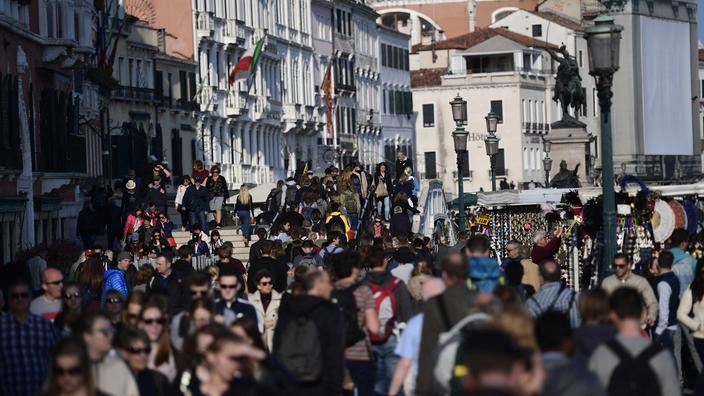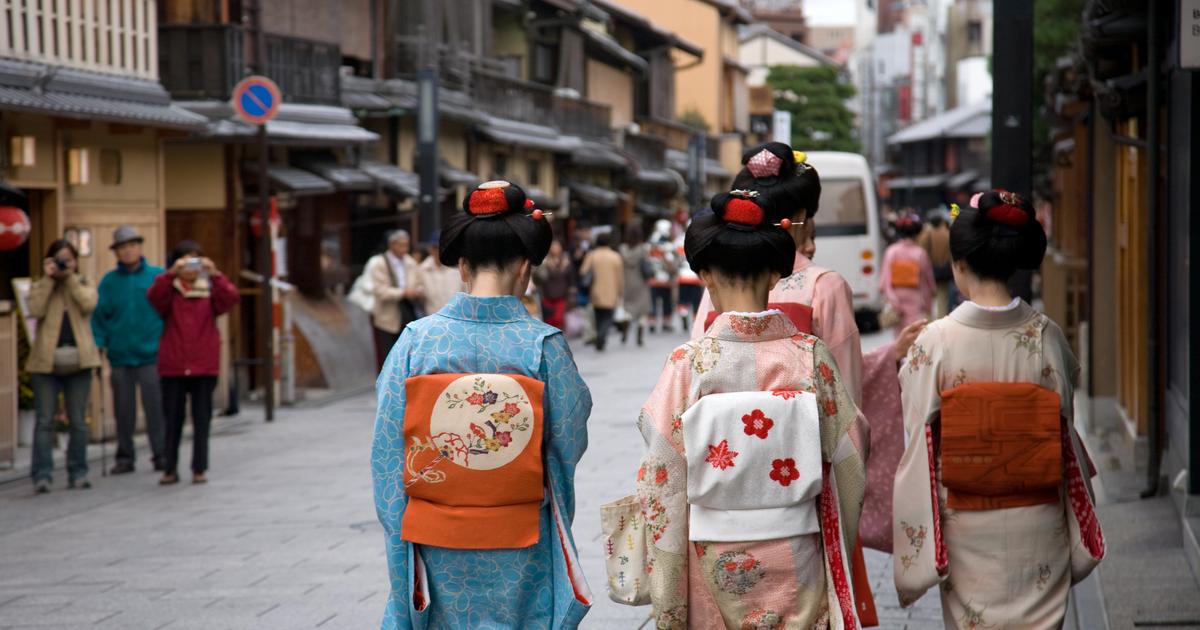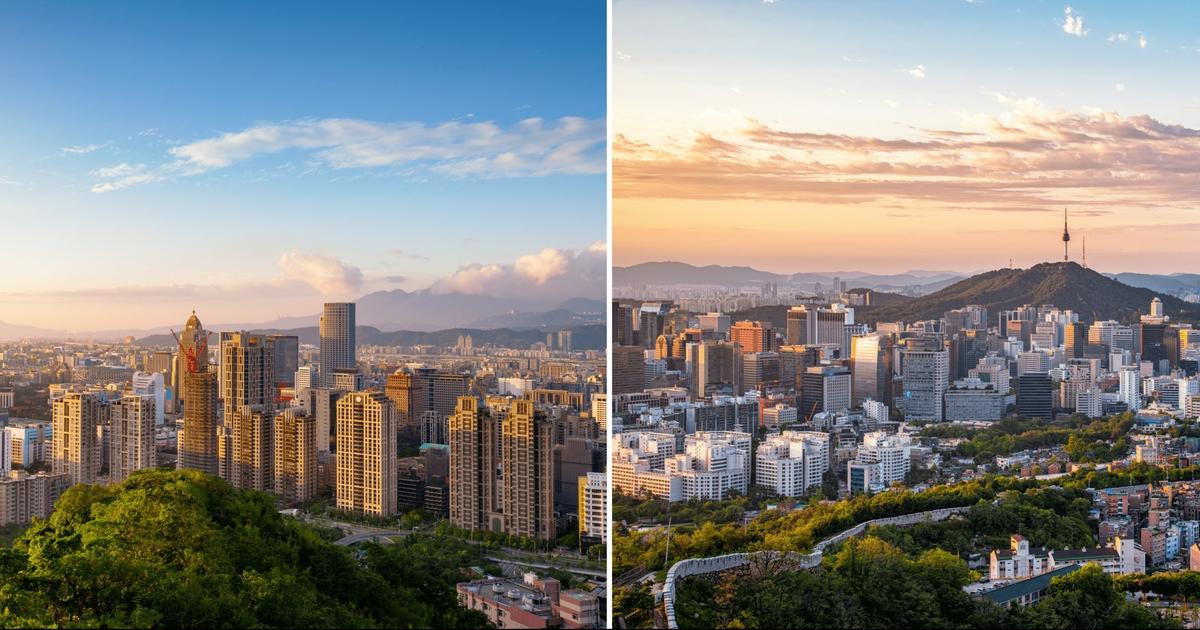Establish a visitor quota, control seasonal rentals, create a new tax or completely close access to a site ... Where tourist traffic exasperates residents and threatens heritage and the environment, local authorities sometimes have to tighten up the opinion. In Venice, the big cruise ships, symbols of pollution and mass tourism, will be banned from the center from August 1, to the great relief of the inhabitants. Radical measures often necessary to preserve the integrity of a place visited beyond its reception capacities.
Tourist overcrowding is not a new phenomenon. Already in 1963, the original cave of Lascaux (Dordogne) closed to the general public, prehistoric paintings being threatened by ... the breathing of the 1,500 daily visitors. In Paris, the Louvre (the most visited museum in the world) had thought in 2019 of making online reservations mandatory to regulate attendance. All over the planet, many national parks and protected reserves have set up entry permits, again to control attendance. But the Covid-19 epidemic has emptied most of the destinations that were still overcrowded two years ago. With this paradox that tourists once hated are now welcomed with open arms where the local economy is lacking ... From Europe to Asia,from historic towns to natural sites, here are 12 tourist places that have implemented measures against the harmful effects of overcrowding.
Read also: Stopped by the Covid-19, will overtourism disappear?
Venice: cruise ship ban and tax for day tourists
Large cruise ships will no longer be allowed in central Venice from August 1, 2021. Miguel MEDINA / AFP
Already threatened by rising sea levels, Venice sees its underwater foundations weakened with each passage of a liner. These cruise ships, which brought 1.4 million visitors out of the 30 million annually before the Covid-19 epidemic, are at the heart of the anti-tourist movement initiated by some of the 50,000 inhabitants who feel increasingly dispossessed by their city. At the beginning of July 2021, the head of the Italian government Mario Draghi announced the ban on liners over 180 meters long and over 35 meters high in the center of Venice; a measure postponed many times which will finally be applied from 1 August.
In addition, tourists who have not booked at least one night in Venice will have to pay a "disembarkation tax" of 3 to 10 euros per day (depending on the period) from 2022. The application of this tax, scheduled for summer 2020, is postponed to promote the return of tourists in the current health context. In addition, certain behaviors, such as walking topless or eating food in front of historic monuments, are punishable by a fine. The opening of new hotels and fast food restaurants is now prohibited. So many measures aimed at preventing Venice from being removed from the UNESCO World Heritage List which it integrated in 1987. In 2021, the City of the Doges is not on the UNESCO list of endangered heritage . But for how long ?
Read also: The Venice of the Venetians in 25 addresses
Marseille: a reservation to access the calanque de Sugiton
Like its neighbors, the calanque d'En-Vau experiences peaks in attendance on sunny days.
Nicolas VOGT - stock.adobe.com
They have never been as crowded as in times of Covid. The creeks of Marseille experienced an unusual attendance last summer. Three million visitors set foot there in 2020. Insecurity, traffic jams, pollution, waste ... This influx causes many nuisances in this protected area. The municipality validated on July 13, 2021 the establishment of a reservation system for the calanque de Sugiton. But not for now. From February 2022, permits, free and registered, will be limited to between 500 and 600 per day, or five times less than during the peaks in attendance observed in summer. In the meantime, sensors have been installed on an experimental basis in order to know the influx in real time in the Calanques park and the roads leading to the Calanques de Morgiou,Sormiou and Callelongue are prohibited from motor vehicles during periods of high traffic (weekends, school holidays, etc.). These measures are accompanied by a “demarketing” campaign aimed at minimizing tourist advertising in the city in order to fight against overcrowding.
Read also: Calanques, gorges of the Ardèche ... These corners of France that will be saturated this summer (and our alternatives)
The island of Porquerolles: no more than 6,000 visitors per day in summer
Porquerolles, in the Port-Cros National Park, a fragile paradise now better protected.
YoF - stock.adobe.com
“
With in Porquerolles 10,000 passengers disembarked in a single day, 2,000 boats at anchor in front of the beaches and more than 1h30 of traffic jams to reach [
the parking lot of
] la Tour fondue, the observation of the 'overflow' is recorded and shared by all
": It is in these terms that the national park of Port-Cros announced in a press release its reopening to the public at the beginning of July 2021. To remedy this overcrowding already observed last summer, the management of the park located off the coast of Hyères (Var) has decided to limit the number of visitors authorized to embark to the island of Porquerolles each day to 6,000.
Until August 31, booking the crossing is compulsory with the TLV-TVM shipping company.
Note that the two other islands in the park, Le Levant and Port-Cros, are not affected by this novelty.
Read also: Porquerolles imposes gauges this summer: what you need to know
The Cinque Terre (Italy): fines for walkers in sandals
Tourists face a fine of 50 to 2,500 euros if they venture out on the hiking trails in flip-flops or sandals. Aliaksandr - stock.adobe.com
The unconsciousness of some tourists is in the crosshairs of the Cinque Terre authorities, 70 km from Genoa, on the Italian Riviera. Since the summer of 2019, it is forbidden to venture on the hiking trails in flip-flops or sandals, at the risk of being fined from 50 to 2,500 euros. This is a reminder that walking on steep and stony terrain must be done with adequate equipment in order to limit the risk of accident. Overcrowding (2.5 million visitors per 4000 inhabitants) is another problem in the five villages of Cinque Terre. A visitor quota was almost introduced in 2016, but the project was abandoned in the face of controversy. Alternatively, the Cinque Terre Card was created to allow tourists access to the entire national park (7,50 euros per day) and / or take the train unlimited between the five villages (16 euros per day).
Read also: Five good reasons to discover Genoa, the superb Ligurian city
Mont-Blanc: reservation in a refuge is compulsory
In summer, climbers must book a night in a refuge to access the summit of Mont-Blanc by the “royal route”.
ARNAUD ROBIN / Le Figaro Magazine
Each year, 25,000 people set off to attack Mont-Blanc, with the risks of insecurity and incivility that this entails. The Haute-Savoie prefecture has taken measures to restrict access to the highest point in the Alps. Since the summer of 2019, up to 214 climbers can take the “Normal route” (also called the “Royal route”) every day. 214 is the number of beds available at the three shelters on the route (Nid d'Aigle, Tête Rousse and Goûter). The reservation of a night (on the dedicated site, by email or by phone) in one of them then acts as a pass. This measure, in force during the opening period of these shelters (from the beginning of June to the end of September), aims in particular to reduce accidents and the number of waste left by mountaineers at altitude.
To read also: For this summer, the mountain is seeking the parade against mass tourism
Barcelona: haro on vacation rentals
Bogatell beach in Barcelona.
Josep LAGO / AFP
The capital of Catalonia is the spearhead of anti-tourist movements in Europe.
The nuisance caused by some of the 30 million annual visitors, in particular on the
ramblas
and the beach of Barceloneta, exasperates the inhabitants who do not hesitate to deploy banners such as “
Tourist Go Home!
»(Tourist, go home!).
In July 2017, far left activists who claimed that “tourism kills the city” went so far as to tag and puncture the tires of a tourist bus.
The municipality of Barcelona has been trying for several years to calm people down by controlling seasonal rentals.
Since 2014, downtown accommodation can no longer obtain a license to be rented on Airbnb-type platforms.
In the outlying districts, a quota has been in place since March 2017 in order not to create an imbalance between the number of tourists and the local population.
An anti-Airbnb front joined by other Spanish destinations such as Madrid and the island of Palma, but also other European cities such as Paris and Amsterdam.
Read also: 48 hours in Barcelona: our addresses and activities for a weekend away from the crowds
The canyon of Fjaðrárgljúfur (Iceland): rush after a clip by Justin Bieber
Attendance at the Fjaðrárgljúfur canyon has increased by 50 to 80% since 2016. Flickr / Andrés Nieto Porras
100 meters high, the canyon of Fjaðrárgljúfur in Iceland was closed for a few months ... and fans of Justin Bieber and
Game of Thrones
are not for nothing.
The Canadian singer shot there at the end of 2015 the music video for his song "
I'll Show You
»While the series has used it as the backdrop for a few scenes.
The natural site then experienced an increase in attendance of 50 to 80% each year.
The hiking trail that leads to the canyon having become muddy from being trampled, hikers have become accustomed to walking parallel to the trail ... and therefore to further damage the vegetation.
The Icelandic Environment Agency therefore closed the site between March and June 2019, time to allow the grass to grow back.
More generally, Iceland has enjoyed spectacular success with the number of tourists increasing from 500,000 in 2010 to 2.4 million in 2018.
Read also: Iceland: our pick of the best hot spring baths
Easter Island (Chile): stays limited to 30 days
Easter Island, 3,500 km from the Chilean coast, is part of the third largest marine protected area in the world. ERIC MARTIN / Le Figaro Magazine
Despite its insularity, Easter Island, located 3,500 km from the Chilean coast, is not spared from overcrowding. Known for its enigmatic stone statues (Moaï), this confetti (162 km²) of the Pacific Ocean welcomes 116,000 tourists per year. Since 2018, the maximum duration of tourist stays has been reduced from 90 to 30 days, including for Chileans. Visitors must comply with several obligations, including filling out a form on arrival, having a hotel reservation or an invitation from a close islander and having a return ticket. The Chilean authorities not only intend to reduce the tourist impact on this thousand-year-old site, but also to limit the production of waste, which is difficult to remove from the island. Since 2015, it has been part ofa marine protected area, the third largest in the world (720,000 km²).
To read also: Easter Island in a wheelchair: "Nothing was impossible, I was the one who decided"
Machu Picchu (Peru): a maximum of four hours
Online reservation is mandatory since 2017 to access Machu Picchu.
XAVIER DESMIER / Le Figaro Magazine
Listed among the Seven Wonders of the World since 2007, Machu Picchu, in Peru, also suffers from overcrowding. The city built by the Inca civilization six centuries ago at an altitude of 2,500 meters is threatened with erosion because of the footsteps of visitors, who are 1.5 million to venture there each year. Restrictions were taken in 2017 to preserve the site: reservation of a time slot on a dedicated site, visit limited to four hours, compulsory presence of a certified guide and limitation of the number of visitors to 5,940 per day. A limit which remains well beyond the 2,500 daily visitors recommended by Unesco, which included it in its heritage in 1983. People who wish to stay on the site for a whole day must book two tickets.The construction project of the new international airport of Chinchero, in the heart of the Inca valley, risks ruining these efforts by bringing in even more people ...
Read also: Peru: the Machu Picchu parade to protect against mass tourism
Uluru (Australia): a sacred rock forbidden to access
Uluru Rock, in the desert center of Australia, is a sacred site for the Anangu aborigines.
BENEDETTA BARBANTI - stock.adobe.com
Uluru (or Ayers Rock) is certainly Australia's most famous rock.
Located in the "red center" of the country, it received the visit of 395,000 people between June 2018 and June 2019, 20% more than the previous twelve months.
An influx that caused wild parking of 4x4s and motorhomes in protected territory.
This is to forget that Uluru, a rock 348 meters high formed 500 million years ago, is a sacred site for the Anangu aborigines.
The latter made their voices heard with the authorities of Uluru-Kata Tjuta National Park, which definitively prohibited its ascent since October 26, 2019. Visitors can still visit the park and thus discover the indigenous heritage.
Read also: Coronavirus: Australia reduces the number of travelers allowed to enter the country
The island of Boracay (Philippines): a big cleanup and a controlled hotel offer
The number of daily visitors is limited to 19,200 per day on Boracay Island, Philippines.
Zhang Chaodao - stock.adobe.com
From April to October 2018, the island of Boracay, in the Philippines, completely closed its access to tourists.
Six months was the length of time it took to clean up an island called a "
septic tank [that] smells like shit
" by the Philippine president himself.
The number of simultaneous visitors, 40,000 per day on average in high season, has since been limited to 19,200.
To enforce this quota, the authorities keep control over the hotel supply and prohibit the development of new establishments.
Visitors must obey new rules like banning smoking and drinking alcohol on the beach and banning water sports other than swimming.
Read also: In the Philippines, Siargao: laboratory for sustainable tourism
Maya Bay (Thailand): a coral reef to regenerate
Closed to tourists since 2018, Maya Bay is expected to reopen at the end of 2021 with a limited number of visitors each day.
Balate Dorin - stock.adobe.com
Garbage, sunscreens, fuels and boat propellers ... The coral reefs of Maya Bay (5,000 daily visitors), in Thailand, have suffered seriously from overcrowding.
This paradisiacal place in the archipelago of Koh Phi Phi was popularized by
La Plage
, a film by Danny Boyle with Leonardo Di Caprio released in 2000. The Thai authorities decided to close the bay to the public in June 2018. A closure first scheduled for four months but which was finally extended until the end of 2021.
When it reopens, the number of visitors will be limited and boats will no longer be able to dock in the bay.
The measure has proven its effectiveness since black tip sharks have reinvested the premises after a few months.
But it will take much more than three years before the ecosystem returns to its original state ...
Read also: Thailand: after Phuket, three other islands reopen to vaccinated international travelers













